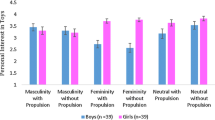Abstract
Although it has been suggested that the early play experiences of girls and boys may contribute to gender differences in cognitive and social development, empirical support for this hypothesis is limited. This paper reports the development of a system of toy classification and may permit a more programmatic investigation of this problem. One hundred adult subjects rated 50 children's toys on 12 “functional” dimensions. Results showed that these toys could be reliably described according to multidimensional similarities and that toys considered appropriate for girls differed in many ways from those considered appropriate for boys. Thus this system may allow us to test more systematically the hypothetical relationship between sex-typed toy play and the development of differential cognitive and/or social skills in girls and boys.
Similar content being viewed by others
References
Block, J. H. Another look at sex differentiation in the socialization behavior of mothers and fathers. In J. Sherman & F. L. Denmark (eds.), Psychology of women: Future directions of research. New York: Psychological Dimensions, 1979.
Block, J. H. Psychological development of female children and adolescents. In P. W. Berman & E. R. Ramey (Eds.), Women: A developmental perspective. Bethesda, MD: National Institutes of Mental Health, 1982.
Bradbard, M. R. Sex differences in adults' gifts and children's toy requests at Christmas. Psychological Reports, 1985, 56, 969–970.
Bruner, J. S. The ontogenesis of speech acts. Journal of Child Language, 1975, 2, 1–19.
Busby, L. J. Defining the sex-role standard in commercial network television programs directed toward children. Journalism Quarterly, 1974, 51, 690–696.
Cherry, L. The preschool teacher-child dyad: Sex differences in verbal interaction. Child Development, 1975, 46, 532–535.
Child, I., Potter, E., & Levine, E. Children's textbooks and personality development. An exploration in the social psychology of education. Psychology Monographs, 1946, 60, 3.
Connor, J. M. & Serbin, L. A. Behaviorally based masculine and feminine preference scales for preschoolers: Correlates with other classroom behavior and cognitive tests. Child Development, 1977, 48, 1411–1416.
DeLucia, L. A. Toy preference test: A measure of sex-role identification. Child Development, 1963, 34, 107–117.
Eisenberg, N. Sex-typed toy choices: What do they signify? In M. B. Liss (Ed.), Social and cognitive skills: Sex roles and children's play. New York: Academic Press, 1983.
Fagot, B. I. Sex differences in toddlers' behavior and parental reaction. Developmental Psychology, 1974, 10, 554–558.
Fagot, B. I., & Patterson, G. R. An in vivo analysis of reinforcing contingencies for sex-role behaviors in the preschool child. Developmental Psychology, 1969, 1, 563–568.
Fein, G. Johnson, D., Kosson, N., Stork, L., & Wasserman, L. Sex stereotypes and preferences in the toy choices of 20-month-old boys and girls. Developmental Psychology, 1976, 14, 527–528.
Liss, M. B. Learning gender-related skills through play. In M. B. Liss (Ed.), Social and cognitive skills: Sex roles and children's play. New York: Academic Press, 1983.
Margolin, G., & Patterson, G. R. Differential consequences provided by mothers and fathers for their sons and daughters. Developmental Psychology, 1975, 11, 537–538.
Meyer, W., & Thompson, G. Sex differences in the distribution of teacher approval and disapproval among sixth grade children. Journal of Educational Psychology, 1956, 47, 385–396.
O'Brien, M., Huston, A. C., & Risley, T. R. Sex-typed play of toddlers in a day care center. Journal of Applied Developmental Psychology, 1983, 4, 1–9.
Parten, M. B. Social play among preschool children. Journal of Abnormal and Social Psychology, 1933, 28, 136–137.
Peretti, P. O., & Sydney, T. M. Parental toy choice stereotyping and its effects on child toy preference and sex-role typing. Social Behavior and Personality, 1985, 12, 213–216.
Piaget, J. The origins of intelligence in children. New York: International University Press, 1952.
Rubin, K. H. The social and cognitive value of preschool toys and activities Canadian Journal of Behavioural Sciences, 1977, 9, 382–385.
Saario, T. N., Jacklin, C. N., & Tittle, C. K. Sex role stereotyping in the public schools. Harvard Educational Review, 1973, 43, 386–416.
Scheffman, J. H. The effects of individual and group play experiences on preschoolers' perspective-taking, referential communication, and number conservation abilities. Unpublished doctoral dissertation, University of Western Ontario, London, Ontario, Canada, 1981.
Serbin, L. A., & Connor, J. M. Sex-typing of children's play preference and patterns of cognitive performance. Journal of Genetic Psychology, 1979, 134, 315–316.
Serbin, L. A., Connor, J, M., Burchardt, C. J., & Citron, C. C. Effects of peer pressure of sex-typing of children's play behavior. Journal of Experimental Child Psychology, 1979, 27, 303–309.
Serbin, L. A., O'Leary, K. D., Kent, R. N., & Tonick, I. J. A comparison of teacher response to the preacademic and problem behavior of boys and girls. Child Development, 1973, 44, 796–804.
Sherman, J. A. Problem of sex differences in space perception and aspects of psychololgical functioning. Psychological Review, 1967, 74, 290–299.
Sprafkin, J. N., & Liebert, R. M. Sex-typing and children's television preferences. In G. Tuchman, A. K. Daniels, & J. Benet (Eds.), Hearth and home: Images of women in the mass media. New York: Oxford University Press, 1978.
Sprafkin, C., Serbin, L. A., Denier, C., & Connor, J. M. Sex-differentiated play: Cognitive consequences and early interventions. In M. B. Liss (Ed.), Social and cognitive skills: Sex roles and children's play. New York: Academic Press, 1983.
Sternglanz, S. H., & Serbin, L. A. Sex role stereotyping on children's television programs. Developmental Psychology, 1974, 10, 710–715.
Tukey, J. W. Comparing individual means in analysis of variance. Biometrics, 1949, 5, 99–114.
Winer, B. J. Statistical principles in experimental design. New York: McGraw-Hill, 1962.
Women on Words and Images, Channeling children. P. O. Box 2163, Princeton, N. J., 1976.
Women on Words and Images. Dick and Jane as victims (rev. ed.). P.O. Box 2163, Princeton, NJ, 1976.
Author information
Authors and Affiliations
Additional information
The author wishes to acknowledge the invaluable contributions of Teresita Borja-Alvarez, Jacqueline Milne, and Susie Goodman at all stages of this project. Much of this work was conducted at The University of Western Ontario, London, Ontario, Canada.
Rights and permissions
About this article
Cite this article
Miller, C.L. Qualitative differences among gender-stereotyped toys: Implications for cognitive and social development in girls and boys. Sex Roles 16, 473–487 (1987). https://doi.org/10.1007/BF00292482
Issue Date:
DOI: https://doi.org/10.1007/BF00292482




